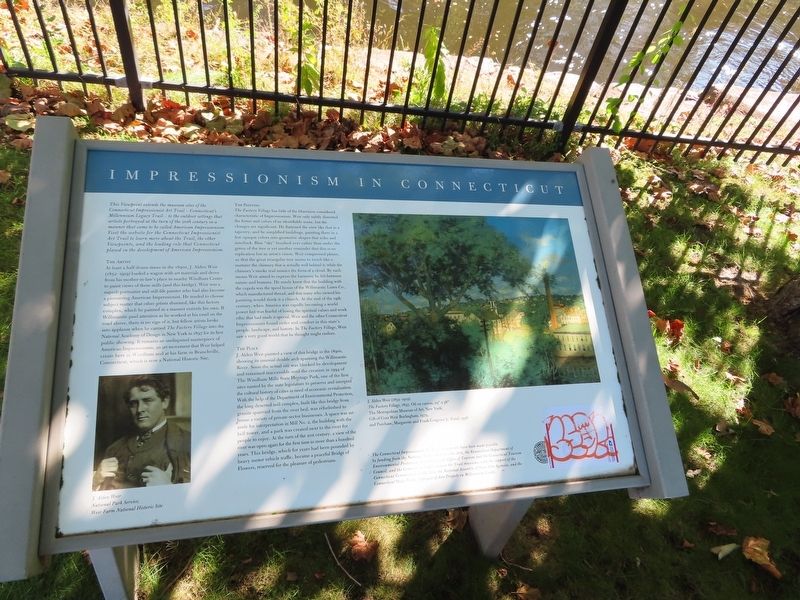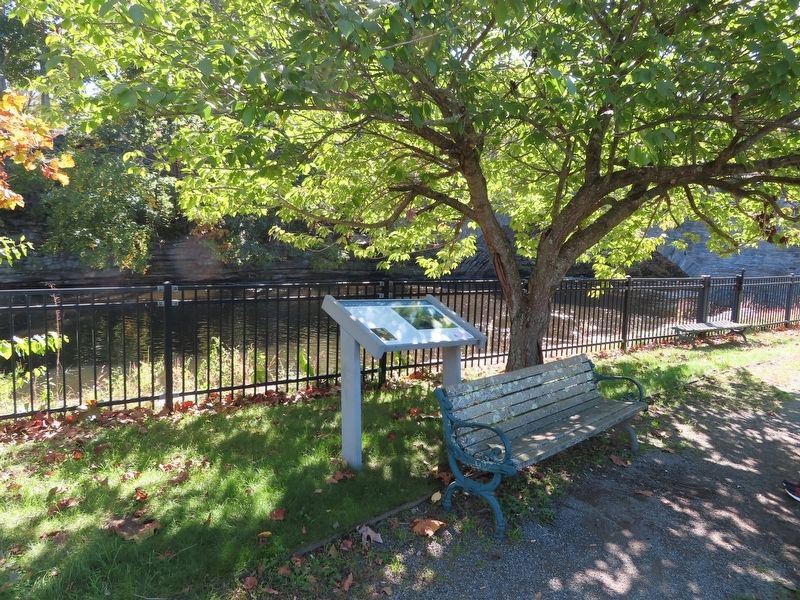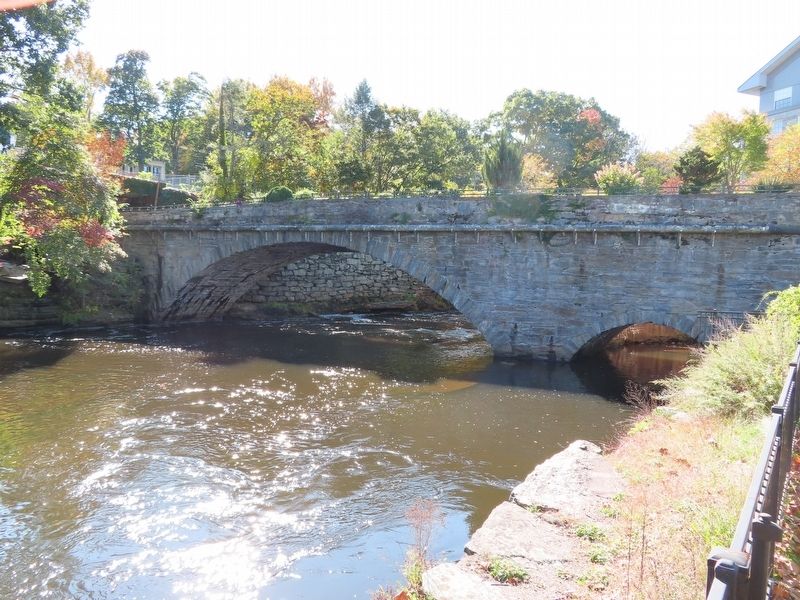Willimantic in Windham in Windham County, Connecticut — The American Northeast (New England)
Impressionism in Connecticut
This Viewpoint extends the museum sites of the Connecticut Impressionist Art Trail - Connecticut's Millennium Legacy Trail to the outdoor settings that artists portrayed at the turn of the 20th century in a manner that came to be called American Impressionism. Visit the website for the Connecticut Impressionist Art Trail to learn more about the Trail, the other Viewpoints, and the leading role that Connecticut played in the development of American Impressionism.
The Artist
At least a half dozen times in the 1890s, J. Alden Weir (1852-1919) loaded a wagon with art materials and drove from his mother-in-law's place in nearby Windham Center to paint views of these mills (and this bridge). Weir was a superb portraitist and still-life painter who had also become a pioneering American Impressionist. He tended to choose subject matter that other artists shunned, like this factory complex, which he painted in a manner entirely his own. If Willimantic paid attention as he worked at his easel on the road above, there is no sign of it, but fellow artists broke into applause when he carried The Factory Village into the National Academy of Design in New York in 1897 for its first public showing. It remains an undisputed masterpiece of American Impressionism, an art movement that Weir helped create here in Windham and at his farm in Branchville, Connecticut, which is now a National Historic Site.
The Painting
The Factory Village has little of the blurriness considered characteristic of Impressionism. Weir only subtly distorted the forms and colors of an identifiable scene, but the changes are significant. He flattened the view like that in a tapestry, and he simplified buildings, painting them in a few opaque colors into geometric shapes that echo and interlock. Blue "sky" brushed over rather than under the green of the tree is yet another reminder that this is no replication but an artist's vision. Weir compressed planes, so that the great triangular tree seems to touch like a nurturer the chimney that is actually well behind it, while the chimney's smoke trail mimics the form of a cloud. By such means Weir aimed to express the harmony he felt between nature and humans. He surely knew that the building with the cupola was the spool house of the Willimantic Linen Co., which manufactured thread, and that many who viewed his painting would think it a church. At the end of the 19th century, when America was rapidly becoming a world power but was fearful of losing the spiritual values and work ethic that had made it special, Weir and the other Connecticut Impressionists found order and comfort in this state's people, landscape, and history. In The Factory Village, Weir saw a very good world that he thought might endure.
The Place
J. Alden Weir painted a view of this bridge in the 1890s, showing its unusual double arch spanning the Willimantic River. Soon the actual site was blocked by development and remained inaccessible until the creation in 1994 of The Windham Mills State Heritage Park, one of the first sites named by the state legislature to preserve and interpret the cultural history of cities in need of economic revitalization. With the help of the Department of Environmental Protection, the long deserted mill complex, built like this bridge from granite quarried from the river bed, was refurbished to house a variety of private-sector businesses. A space was set aside for interpretation in Mill No. 2, the building with the bell tower, and a park was created next to the river for people to enjoy. At the turn of the 21st century, a view of the river was open again for the first time in more than a hundred years. This bridge, which for years had been pounded by heavy motor vehicle traffic, became a peaceful Bridge of Flowers, reserved for the pleasure of pedestrians.
The Connecticut Impressionist Art Trail Viewpoints have been made possible by funding from the National Endowment for the Arts, the Connecticut Department of Environmental Protection, the Connecticut Office of Tourism and the Connecticut Tourism Council,
and the Connecticut Impressionist Art Trail museums, with the support of the Connecticut Commission on the Arts, the National Assembly of State Arts Agencies, and the Connecticut State Parks. A project of Arts Projects on Millennium Trails.
( photo captions )
— J. Alden Weir
National Park Service
Weir Farm National Historic Site
— J. Alden Weir (1852-1919)
The Factory Village, 1897, Oil on canvas, 29" x 38"
The Metropolitan Museum of Art, New York;
Gift of Cora Weir Burlingham, 1979,
and Purchase, Marguerite and Frank Cosgrove Jr. Fund, 1998
Topics. This historical marker is listed in this topic list: Arts, Letters, Music. A significant historical year for this entry is 1897.
Location. 41° 42.587′ N, 72° 12.357′ W. Marker is in Windham, Connecticut, in Windham County. It is in Willimantic. Marker can be reached from Main Street (Connecticut Route 66) east of Clark Street, on the right when traveling east. Located in Heritage River Park. Touch for map. Marker is at or near this postal address: 440 Main Street, Willimantic CT 06226, United States of America. Touch for directions.
Other nearby markers. At least 8 other markers are within walking distance of this marker. Thread City Crossing (approx. 0.2 miles away); Windham Tercentenary (approx. 0.7 miles away); Windham World War I Monument (approx. 0.7 miles away); Staff Sgt. John V. Morascini (approx. ¾ mile away); Co.L First Inf. Memorial (approx. 0.8 miles away); Merchant Marine Veterans Memorial (approx. 0.8 miles away); Polish National Home World War II Monument (approx. 0.9 miles away); White Eagle World War II Monument (approx. 0.9 miles away). Touch for a list and map of all markers in Windham.
Also see . . .
1. J. Alden Weir (Wikipedia). (Submitted on October 10, 2022, by Michael Herrick of Southbury, Connecticut.)
2. Weir Farm National Historic Site. (Submitted on October 10, 2022, by Michael Herrick of Southbury, Connecticut.)
Credits. This page was last revised on June 27, 2023. It was originally submitted on October 10, 2022, by Michael Herrick of Southbury, Connecticut. This page has been viewed 54 times since then and 4 times this year. Photos: 1, 2, 3. submitted on October 10, 2022, by Michael Herrick of Southbury, Connecticut.


